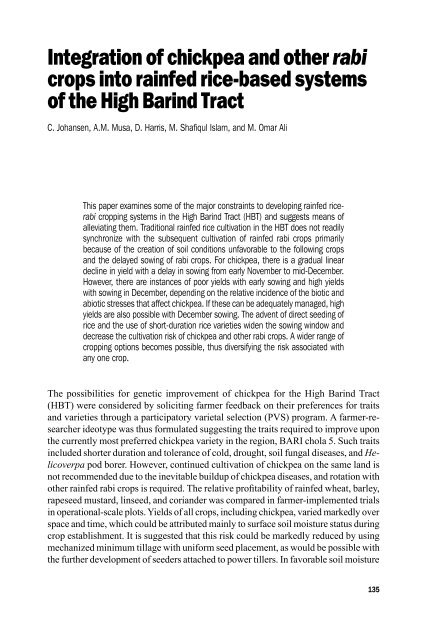Download (2461kB) - University of Greenwich
Download (2461kB) - University of Greenwich
Download (2461kB) - University of Greenwich
- No tags were found...
You also want an ePaper? Increase the reach of your titles
YUMPU automatically turns print PDFs into web optimized ePapers that Google loves.
Integration <strong>of</strong> chickpea and other rabicrops into rainfed rice-based systems<strong>of</strong> the High Barind TractC. Johansen, A.M. Musa, D. Harris, M. Shafiqul Islam, and M. Omar AliThis paper examines some <strong>of</strong> the major constraints to developing rainfed ricerabicropping systems in the High Barind Tract (HBT) and suggests means <strong>of</strong>alleviating them. Traditional rainfed rice cultivation in the HBT does not readilysynchronize with the subsequent cultivation <strong>of</strong> rainfed rabi crops primarilybecause <strong>of</strong> the creation <strong>of</strong> soil conditions unfavorable to the following cropsand the delayed sowing <strong>of</strong> rabi crops. For chickpea, there is a gradual lineardecline in yield with a delay in sowing from early November to mid-December.However, there are instances <strong>of</strong> poor yields with early sowing and high yieldswith sowing in December, depending on the relative incidence <strong>of</strong> the biotic andabiotic stresses that affect chickpea. If these can be adequately managed, highyields are also possible with December sowing. The advent <strong>of</strong> direct seeding <strong>of</strong>rice and the use <strong>of</strong> short-duration rice varieties widen the sowing window anddecrease the cultivation risk <strong>of</strong> chickpea and other rabi crops. A wider range <strong>of</strong>cropping options becomes possible, thus diversifying the risk associated withany one crop.The possibilities for genetic improvement <strong>of</strong> chickpea for the High Barind Tract(HBT) were considered by soliciting farmer feedback on their preferences for traitsand varieties through a participatory varietal selection (PVS) program. A farmer-researcherideotype was thus formulated suggesting the traits required to improve uponthe currently most preferred chickpea variety in the region, BARI chola 5. Such traitsincluded shorter duration and tolerance <strong>of</strong> cold, drought, soil fungal diseases, and Helicoverpapod borer. However, continued cultivation <strong>of</strong> chickpea on the same land isnot recommended due to the inevitable buildup <strong>of</strong> chickpea diseases, and rotation withother rainfed rabi crops is required. The relative pr<strong>of</strong>itability <strong>of</strong> rainfed wheat, barley,rapeseed mustard, linseed, and coriander was compared in farmer-implemented trialsin operational-scale plots. Yields <strong>of</strong> all crops, including chickpea, varied markedly overspace and time, which could be attributed mainly to surface soil moisture status duringcrop establishment. It is suggested that this risk could be markedly reduced by usingmechanized minimum tillage with uniform seed placement, as would be possible withthe further development <strong>of</strong> seeders attached to power tillers. In favorable soil moistureIntegration <strong>of</strong> chickpea and other rabi crops into rainfed rice-based systems <strong>of</strong> the High Barind Tract 135
















